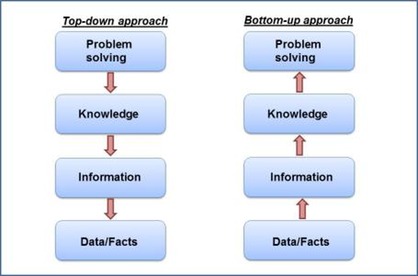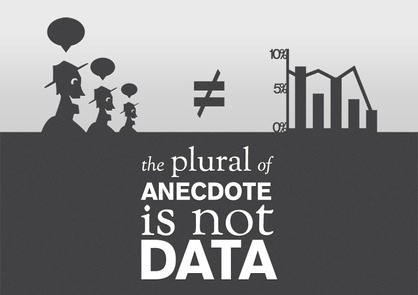Veni, Vidi, Duci (Blog)
The Plural of Anecdote Is (Not?) Data
On various occasions (most recently today in an email message), I have heard it said that, "The plural of anecdote is not data." Curious as to where this originated, I did a quick web search using my search engine of choice. Some, like the Quotes About Data Processing website attribute the statement to Frank Kotsonis. Others, like the source of the above image, credit Roger Brinner. Others claim that the original statement was the opposite, i.e. "The plural of anecdote IS data." by Raymond Wolfinger. Two implications (of the original statement) found at the previous link are: 1) data is usually collected in the first place because anecdotal evidence flagged something as worthy of investigation, and 2) the idea that data alone can prove something as true, while anecdotes cannot is absurd. Neither data nor anecdotes prove anything. Scientific theories are never, ever, ever proven. They can only be disproven.
In looking around online, I found that others have similarly spent time wondering about and even blogging on this topic. Check out Skeptical Medicine for one such example.
How Can We Tame Wicked Messes?
The title of this post comes from David Hancock's 2010 book Tame, Messy, and Wicked Risk Leadership. Also, thanks to Mark Phillips for the inspiration behind this post; re-reading his article "Using Risk Management to Solve Strategic Problems," which appeared in Oct 2012 in Small Wars Journal was the motivation for my thinking about this topic.
First, some definitions regarding the different types of problems (and risks) … tame, wicked, and messy problems (according to Hancock).
A tame problem (risk) has straightforward, often linear, causal relationships and can often be solved by analytical methods. Got it; we've been dealing with these for eons.
A messy problem (risk) has a high level of system complexity and may have various interrelationships or interdependencies that require a holistic approach. Even these are not uncommon.
A wicked problem (risk) is characterized by a high level of behavioral complexity, i.e. people who do not act in predictable ways. A fair amount has been written about these in recen tyears.
So then … what is a wicked mess? Somewhat obviously, it is a problem (risk) with both behavioral AND systemic complexity, often with interaction between them.
While Hancock primarily considers problems from engineering and acquisition, Phillips suggests that they can be used in strategy development, even at the national level. He proposes (rightly, IMO) that most significant policy challenges can be categorized as wicked messes. The question then becomes … how does this help us in addressing them?
Top-Down or Bottom-Up Analytics?
Should your approach to analytics be top-down (strategic) or bottom-up (operational)? Both approaches have merit, but I would argue that you shouldn't rely on just one. To understand the difference between the two approaches, look at the image below; this figure (and the entire idea for this entry), comes from Morten Kamp's "All About Human Capital" blog.

Many take the bottom-up approach, perhaps because it is easier. They look through their available data (or "Big Data" for some) and look for ways to measure, visualize, and trend it, looking for links between the data and things they think are important. OK; there's some value there, in that good analytics from a bottom-up strategy can show you connections you hadn't seen before and maybe even challenge your business strategy.
In comparison, the top-down approach starts with the business strategy and looks for areas to focus operational efforts. Then, you find the desired knowledge you require to make the right decision. The you design the data required to provide you with this knowledge.
Bottom line … analytics is one tool to help leaders make better decisions. Depending on the type of decisions you are making (i.e. strategic or operational), your approach to analytics must also change. Don’t just look at the data you currently have (but do that too); instead what data you need to create the most value from your analytics effort.
The Academic - Practitioner (Non)-Divide
In the past, when I renewed my membership to the Institute for Operations Research and Management sciences (INFORMS), one of the questions I was asked to answer to update my membership profile bothered me. The question provided only two checkboxes, of which only one could be selected. Specifically, I was asked to identify myself as primarily an "Academic" OR a "Practitioner" (of Operations Research, or OR). (Note the two different uses of the word/acronymn "OR" in the previous sentence.)
However, I consider myself to be both an academic AND a practitioner. If you consider there to be a fence or dividing line between the two, I would say that I have one foot firmly on the ground on either side of it. But, I don't see it as being quite so clear cut. For OR practitioners, it is important to have a solid academic background supporting your work. Similarly, to be a good academic, having practical experience is invaluable to both teaching and research efforts.
Upon renewing my membership for 2013, I noticed that the question is now more clear in that it asks for the "primary employment classification" and offers five choices -- academic, government, business, consulting, retired/underemployed/other. And, there is another question that allows members to specify the various roles that they perform.

